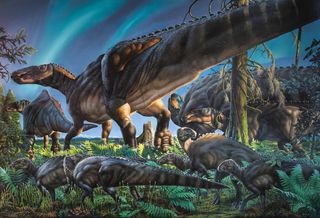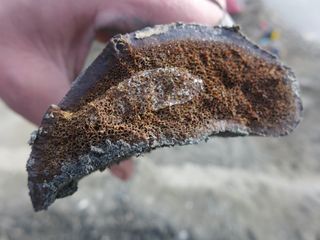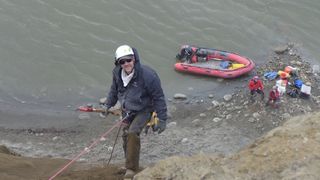Brrr! Duck-Billed Dinosaur Lived Through Alaska's Snowy Winters

Deep in the dark, snowy wilds of Alaska, a herd of young duck-billed dinosaurs rambled across the frozen Earth. But something cut their lives short, and they remained there, crushed, until scientists discovered their remains, 69 million years later.
Exactly how the 30-foot-long (9.1 meters) herbivores managed to survive the cold is unclear. But the finding — almost 10,000 bones of mostly juvenile individuals — has set a new record: No other dinosaur fossils have been found this far north, the researchers said.
"The finding of dinosaurs this far north challenges everything we thought about a dinosaur's physiology," lead researcher Greg Erickson, a professor of paleobiology at Florida State University, said in a statement. "It creates this natural question: How did they survive up here?"
Oil geologists first found the fossils in what is now Alaska in the 1980s, and researchers at the University of Alaska began excavating them in the 1990s. More recently, archaeologists at Florida State University joined them, and "some of the key bones that helped show this was a new species we found on our last few expeditions," Erickson, who is originally from Alaska, told Live Science. [See Excavation Photos of the Duck-Billed Dinosaurs in Alaska]

Researchers named the new species Ugrunaaluk (oo-GREW-nah-luk) kuukpikensis, which means "ancient grazer of the Colville River" in the language of the Alaskan native Iñupiaq culture. (Kuukpik is the Iñupiaq name for the Colville River.)
At the time this dinosaur lived — during the Late Cretaceous — Earth had a warmer climate, and the area that's now Alaska was covered in trees. But Alaska was still a chilly place, as it sat much farther north, above the paleo-Arctic Circle at about 80 degrees latitude. There, the air temperatures were an average of 43 degrees Fahrenheit (6 degrees Celsius), and it had snowy and dark winters.
Researchers have found other dinosaur fossils in Alaska, including track marks belonging to other duck-billed dinosaurs — as well as footprints from ceratopsians (a group of herbivorous, beaked dinosaurs that includes triceratops), therizinosaurs (bipedal herbivores) and flying reptiles known as pterosaurs — in Denali National Park. But this is the first time researchers have found Ugrunaaluk kuukpikensis fossils, and the first time they've found any dinosaur fossils this far north.
Sign up for the Live Science daily newsletter now
Get the world’s most fascinating discoveries delivered straight to your inbox.
Frozen bone bed
Most of the Ugrunaaluk kuukpikensis bones are from a single rock layer called the Liscomb Bonebed within the Prince Creek Formation — a unit of rock that was deposited on an Arctic coastal floodplain about 69 million years ago. The layer, which is about 2 to 3 feet (0.6 to 0.9 m) thick, contains thousands of fossils, mostly from young or juvenile duck-billed dinosaurs, or hadrosaurs, that stood 3 feet tall (1 m) at the hip.
It's possible that the fossils are from a herd of juveniles that were killed suddenly, the researchers said.

A bone analysis showed that the newfound species is closely related to Edmontosaurus, another type of hadrosaur that lived about 70 million years ago in present-day Alberta, Montana and South Dakota. However, the researchers did not find any Edmontosaurus fossils at the site.
The researchers plan to look for more fossils at the Prince Creek Formation, but the site is difficult to reach. In addition to bearing the cold weather, the team must use bush planes that can land on gravel bars, travel in inflatable boats to the sites and often rappel down the side of cliffs to dig for bones. [Album: Discovering a Duck-Billed Dino Baby]
But those efforts have yielded spectacular findings: The formation is rich with skeletons, and researchers have already found the fossils of birds, small mammals, fish and at least 13 different dinosaur species, based on teeth and other remains.
"We are basically uncovering a lost world of dinosaurs that we never imagined could have existed in the Arctic," Erickson told Live Science. "Alaska is truly the last frontier for dinosaur paleontology."
The public can see three full skeletons of Ugrunaaluk kuukpikensis at the University of Alaska Museum of the North. The findings were published online today (Sept. 22) in the journal Acta Palaeontologica.
Follow Laura Geggel on Twitter @LauraGeggel. Follow Live Science @livescience, Facebook & Google+. Original article on Live Science.

Laura is the archaeology and Life's Little Mysteries editor at Live Science. She also reports on general science, including paleontology. Her work has appeared in The New York Times, Scholastic, Popular Science and Spectrum, a site on autism research. She has won multiple awards from the Society of Professional Journalists and the Washington Newspaper Publishers Association for her reporting at a weekly newspaper near Seattle. Laura holds a bachelor's degree in English literature and psychology from Washington University in St. Louis and a master's degree in science writing from NYU.
Most Popular

